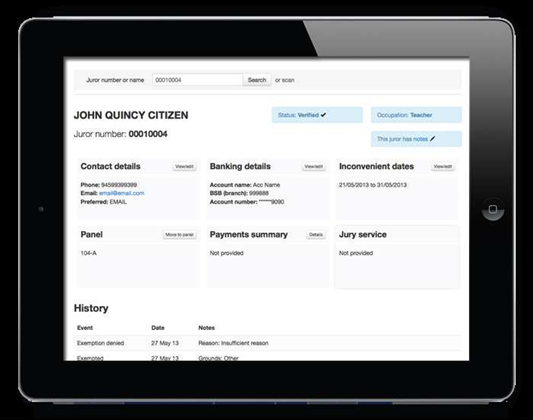The IT team housed within the NSW Attorney-General’s department is putting the finishing touches to a $4.2 million jury management system that the project lead believes is “world-class”.

The system will replace the 20-year-old jury roll system (JRS) which is nearing cessation of support.
The jury management system stores information on jurors and contains algorithms that are used to randomly select around 200,000 jurors each year from the four million-strong NSW electoral roll.
The new system will allow the public to apply online to be excused or deferred from jury duty, to specify payment preferences, or review duties and schedules.
It also enables potential jurors to receive notifications about their case by SMS or email. But contrary to previous media reports which stated potential jurors would receive summons by SMS, summons and notice of inclusions documents will continue to be sent on paper.
Project lead Julian Huxham told iTnews the system being replaced - based on Software AG’s Adabas Natural database - is a “very clunky green screen that you have to memorise codes and use 54 screens to drill down to what you want.”
“It had no global search and was very difficult and cumbersome,” he said. “The idea was to replace it and make it easier for the internal staff to use, as well as improve the overall service that is provided to prospective jurors.”
The new jury management system is custom built — against the department’s initial wishes, which favoured an off-the-shelf solution — on a Java platform, including the Spring framework, Hibernate object-relational mapping (ORM) library and Apache Maven build automation tool.
“We’ve managed to completely rebuild a legacy, complex, ageing core system [with] secure web interfaces into other agencies in just under a year, and we’ve done it in a way that it is responsive to mobiles, tablets and smartphones,” Huxham said.
“We will deliver what I consider to be a world class, world-first service that hopefully can be an exemplar for how to deploy technical projects in government.”
The team has migrated up to 16,000 records across from the old system, mainly relating to citizens who have been excused from jury duty as well as those who are deceased.
Bringing the public onboard
Development began in November last year. The team is currently around 74 percent of the way through the new JMS core — above its target of 67 percent — and around 34 percent along the path to the next phase, the public interface.
The team took a mobile-first and cross-platform for operating systems approach. Huxnam has placed a strong emphasis on the user interface — one of his team is a designated user experience specialist — and the public interface has been custom built to be accessible across all mobile operating systems and web browsers.
“The core difference to the project versus many other in government is we had a very strong focus on the user experience,” Huxham said.
“It’s about really understanding the end-to-end service economy and designing in a way that really understands the context of use, providing something that would be easy and intuitive to use - in a ‘walkup’ sense like an ATM.”
The team made use of Bootstrap - a framework for creating websites and web applications developed by the devs at Twitter - and accompanying Font Awesome font, as well as the Handlebars template library.
“We’ve just done user testing with 50 people. The previous system would have taken five weeks of training and probably 10 minutes to find information, now it takes under 30 seconds,” Huxham said.
Huxham and his team will soon embark to Griffith to undergo user testing to ascertain whether any big holes exist in the new system.
Agile development
Huxham brought in six consultants to work on the project, who under his leadership have been working with the agile scrum methodology for software development.
“I’ve been very particular about the delivery focus and the effective combination of agile development, user-experience and service design and delivery,” he said.
“We’ve never missed a deadline, and we’ve been able to proceed because of the aptitude of the team, the use of the correct tool suite (Atlassian and other open-source tools) — with a very effective solution architecture.
“The business has been involved in the review of deliverables every two weeks. We have been religious about daily stand-ups, review sessions and Sprint retrospectives.”
Huxham said the team’s documentation of the process alongside its use of best tools and procedures meant they had never received a change request on the project.
“We’ve just been through a rigorous 26-day external [PricewaterhouseCoopers] audit and they were impressed with our approach and how we are implementing agile,” he said.
“People think agile is lean and you don’t need to document things - we have adopted the necessary overhead of defining our stories well, we’ve put in the overhead and we actually think this is exemplar for how projects should be in government.”
Huxham expects to have the entire project completed ahead of time at the end of February, including accommodating any changes arising out of the user testing exercise.
Read on for how Huxham and his team got past a staid government attitude to procurement.




_(20).jpg&h=140&w=231&c=1&s=0)
_(22).jpg&h=140&w=231&c=1&s=0)



_(26).jpg&w=100&c=1&s=0)

 iTnews Executive Retreat - Security Leaders Edition
iTnews Executive Retreat - Security Leaders Edition












_(1).jpg&h=140&w=231&c=1&s=0)



